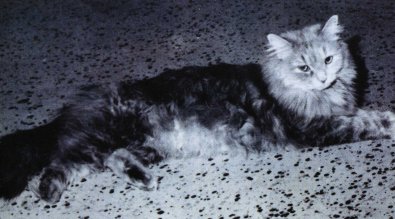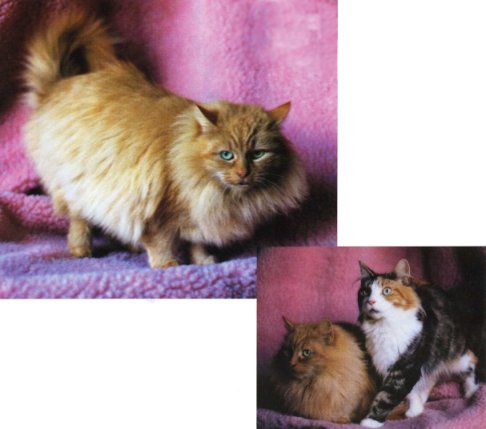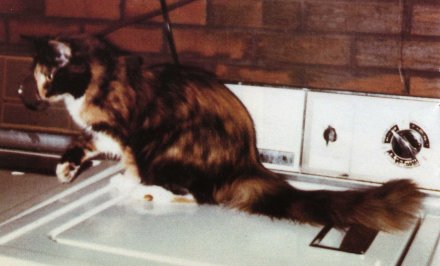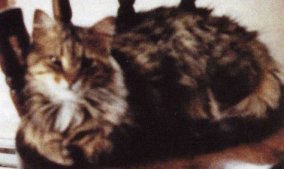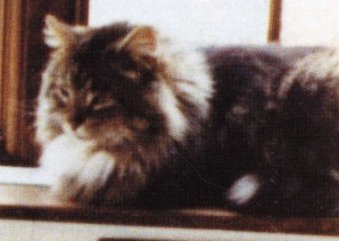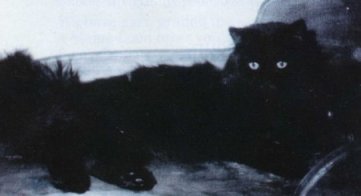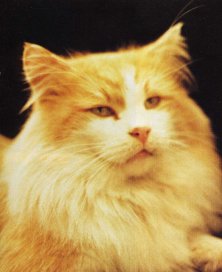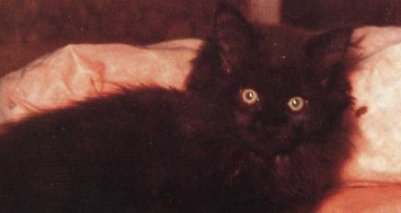| "This page was originally a part of the Maine Coon Heritage Site, a site that was first created in 1998 by Cynthia Bowen (Coontopia), Ulrika Olsson (Ylletrollets), Astrid Straver (Tricks and Tails) and Janet Marr (Furkats). It was then taken over by PawPeds, and it is now split up to fit better with the structure of PawPeds' website." |
 |
The Beth Kus Interview Dirigo Cattery
Dirigo Cattery, January 1995.
|
Whittemore Chick-A-Dee (Blue-Cream Female). Photo |
Our gratitude goes to Beth Kus, of Dirigo Maine Coons, who has given up so much time in her very busy schedule to satisfy our curiosity and, as our mail has shown us, that of the rest of the world.
Beth has answered our questions with so much patience that we present it here in a 'Question and Answer' format to keep her personal view intact. The questions are abbreviated to allow more room for the replies.
What was the original conformation and approximate weight of the Maine Coon in the wild?
The original weight, estimated through experience, of personally observed Maine Coons of no pedigree would be somewhat smaller than today's better-fed cats. I would estimate weights of 8-9 Ibs (3.5-4 kg) with some females being nearer 6 Ibs (2.7 kg), males being 10-15 Ibs (4.5-6.5 kg), not overweight, in ordinary condition. The body type, though, is always distinct.
|
top: CFA Ch Dirigo Arundel (Red Mackerel Tabby Female), 21.3.89. |
What was the original coat like and have you stayed with that type or tried to change it in any way?
I breed the original coat type here at Dirigo Cattery; the type that is distinguished by heavy, coarse guardhairs that glisten in the sun, and it fills with a downy, finer insulating layer for the sub-zero temperatures of the northeastern US. This coat is exemplified by the photo of Dingo's Arundel. I have noticed at cat shows that the newer coats were going finer overall for the past 10 years or so, since Heidi Ho has become 90% part of the breed. Since I never felt the fur of the Heidi Ho foundation pair, though, I can only assume that the crosses resulting with them produced the finer coats now shown. These fine coats are dried by excessive shampoos to make them appear to have the body of the original coats. The original coats need two days before a show, after shampooing, to regain loft and full lustre. The original cats were unevenly shaggy. Even coat length is a sign of a non-pure Maine Coon, more Angora type, and those cats should not be selected for breeding, unless other reasons outweigh the coat.
|
Heidi-Ho Georgie Girl of Ktaadn (Tortie & White Female), 9.5.74. |
And the tail?
Tails have almost always gone to the shoulders.
What about lynx tips, ear furnishings and snowshoes?
Lynx tips are not as pronounced in foundation Maine Coon cats. They have been improved by breedings. The photo of 'Tobey' from F. Simpson's book clearly shows his white lynx tips as present but not overlong. The frills, though, have always been lovely. The snowshoe fur padding has always been present but, since foundation Maines actually walk around outside in Maine, going about their cat lives, the snowshoes get worn down. You did not ask about ruffs and this is a good paragraph to mention that ruffs in the wild are perhaps longer, due to survival needs.
|
Joey, a stray, pictured from the same |
Were there any solid whites? If not, where did the whites come from?
My friend, Lida Choate, the elderly lady who breeds a very oldfashioned type, has always mentioned that it is known that Rockland, Maine, is an area where the whites can be located. There is some talk of one of the coastal islands having whites, too, perhaps Deer Isle, but I don't know which island.
Where did the silver gene come from? It seems that black smokes are often quite different from other Maine Coons. Is it the smoke gene itself or the lines they come from?
There is a family in Monmouth, Maine who has for nearly 30 years always had a black smoke kitten or two come through in their barn cats' litters. While driving past the farm one day, my husband and I noticed a black smoke cat sitting on the lawn. We stopped and turned around. It turned out that we know the family from school days and asked about the cats. They were Maine Coons and the mother of the black smoke was a stunning calico. Her head type would be acceptable to CFA but the black smoke adult female did have a slightly more soft muzzle shape. Future kittens had good muzzles but that cat group was not destined to be part of the breed as a whole, due to its environment and the owner's preference that they continue to be her mousers!
|
Fluffanutter of Abnaki (Brown Tabby & White Male) |
Another time, I visited Deb Hunter, who bred under the name Tippecanoe but, to my knowledge, none of her cats are in the breed now. She had a group of at least 20, and a neighbour of hers told me that at one time the number was far higher than that. They were beautiful in colour, brown classic, blacks and a few dilute calicos. I think she must have had some mackerels, too, but it has been at least 5 years since the visit and I just can't remember. She had a young male who was her best stud, who was classic. The head type varied from too oddly round at the top of the skull, behind the ears, to excellent.
Were you involved in the setting of the original show standard?
No, I was too young in the '60s to do much more than school work. I was born in 1950 so, when MCBFA was established, I was too young to be acquainted with the individuals. But a note of interest here - I am establishing a foundation breeders' group this year, to unite the people in the Northeast who work with the native cats. Later, there will be more reports about this new group.
|
"Mumbo" - Norwynde Li'l Black Mumbo of Ktaadn. |
As the Maine Coon spread away from Maine across the country, has it changed to different effect in different areas? In your opinion, should there be one, or several 'looks'? Have the different looks been bred or were they all different in the wild?
I think it is fun to have different looks, because there is more room for more opinions, that way, and cat breeders love their opinions! In my observation, which has been confined to the New England states, there are very different looks now prevalent. Maine has many traditional breeders who live very far away from shows and the Heidi Ho look is not as common. The different looks have been deliberately selected for.
|
Dirigo Swift River Ruffian |
What did your own original Maine Coons look like? Have you done anything to deliberately change their look?
My original pair of Maine Coons were CFA standard, even by today's interpretation. Back then, I had an odd attitude about taking pictures of pets and, as a consequence, have practically no photos of the early Dingo cats. Since then, my attitude has come full circle and I am an amateur photographer, with my cats as my best artistic subjects! The most noticeable variation in the early litters was the ear set. That would vary a lot. As my breedings for show type improved, so did the occurrence of predictable ear set.
What do you see as the major differences between today's Maine Coons and that of 20 years ago? Which do you prefer? Are foundation cats still widely used in the US?
The major difference between the Maine Coons of today's show ring and that of 20 years ago is SIZE. Foundation cats are bred by a limited few dedicated individuals who care more for the real thing than for society's ribbons and accolades. For myself, the payback is the unspeakable joy of the pet owner!
|
Sally's Black (Black Kitten) 21.7.73. Sire King Kristophe. |
Were there any known genetic anomalies in the original cats? Have they been made worse or eliminated by selective breeding?
Everyone has come to believe that the genetic anomalies that came in with some foundation lines were myriad but the big size made people overlook much. After all, a show-winning cat brought so much pride of ownership that, when the offspring started dying and sometimes even the winner itself, the ego and pride of the person just denied the difficulty and they brought out the newest and youngest example. Which went on to win, and so on and so on, you see.
What particular intention did you start with — stabilising, changing, heads, coats, colours...? Did your intentions change with time?
The intention that I started out with at Dirigo Cats of Maine was to share the joy that my special cats brought to my family. Also, as time went on, it was to see Dirigo cats assume their rightful niche within this breed that just wouldn't be the same without everyone's bloodline. I believe that these goals have been successfully met and am now reaching out to other foundation breeders to help them get the recognition they deserve for their cats.
Foundation lines, Maine Origin looks

Could this be the earliest existing picture of the Maine Coon? Dating from 1903, it is believed to be a red and white. 100 years later the type has changed but this is still 100% Maine Coon.
Our thanks to Beth Kus's husband, Crawford, for this photograph.
© "Maine Coon International", issue 2, 1995.
Reprinted with permission.

